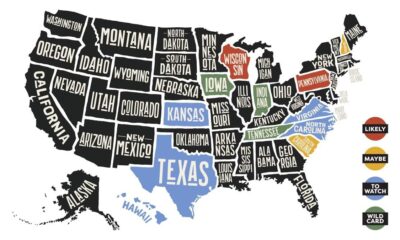Cannabis News
The Cheers of Cannabis Cafes
Published
2 years agoon
By
admin

Regulators in the Massachusetts marijuana industry made a decision this past Monday to abandon previous plans for a limited pilot program involving cannabis cafes and social consumption sites in twelve municipalities. One official said this move would help get the voter-approved market sector online “a little quicker.”
The Cannabis Control Commission changed course from earlier restrictions that would have limited the launch to a dozen cities and towns nine months after a new state law defined a procedure for cities and towns to permit on-site usage of cannabis products.
In contrast to the current retail establishments that have been operating for years, CCC personnel will now begin to develop a regulatory framework giving permits to sites where customers will be able to buy and consume cannabis products on the premises.
Shifting Focus to Regulatory Framework and Longer-Term Questions
Commissioner Nurys Camargo, a member of the working group that proposed the change in approach, emphasized that dropping the pilot program would enable municipalities to decide whether they want to embrace social consumption. This shift allows regulators to focus on addressing long-term industry concerns rather than being consumed by the operation of a limited pilot program.
Camargo explained that while this adjustment serves as a parallel track to expedite the creation of social consumption opportunities, it should be noted that the implementation process will still take time. With removing the pilot project, the commission can now concentrate on defining the regulatory framework, determining licenses, and envisioning what social consumption will look like. Camargo highlighted the potential delays that a pilot license could introduce to the regulatory process, with the likelihood of being entangled in regulations for several years.
The decision to eliminate the pilot program language received support from Commissioners Ava Callendar Concepcion, Camargo, Stebbins, and CCC Chair Shannon O’Brien. However, O’Brien voiced her concerns about unresolved issues related to secondhand smoke, impairment, and ensuring the success of equity applicants, microbusinesses, and craft cooperatives. O’Brien stressed the importance of getting these aspects right during the exclusivity period to avoid hindering opportunities for those involved.
Commissioner Kimberly Roy abstained from voting, citing insufficient information regarding public safety, public health, and equity impacts. Roy cautioned that well-intentioned initiatives such as delivery operators, microbusinesses, and craft cooperative farmers could encounter challenges or fail to achieve their intended goals.
In the final vote, all other commissioners voted in favor of eliminating the pilot program, signaling their agreement with the decision. This collective support indicates a unified stance within the commission on moving away from the limited pilot program approach and focusing on developing a comprehensive regulatory framework for social consumption in the marijuana industry.
Background and Concerns Delaying Cannabis Cafe Launch
Voters supported a ballot measure legalizing marijuana for recreational use in 2016, including language allowing marijuana use “on the premises where sold” and at special regulated events. However, over seven years later, public cannabis cafés have not yet opened.
When then-Gov. Charlie Baker and Attorney General Maura Healey expressed concerns about the speed of the rollout in 2018, and regulators put the breaks on. Baker was succeeded in the governor’s office by Healey.
In addition, Baker spent years trying to change the state’s drugged driving rules but ran into opposition in the Legislature.
In 2019, the CCC’s working group proposed starting a pilot program for social use, and officials also decided that the Legislature needed to alter state law to give cities and towns the framework they needed to permit on-site cannabis use. This modification was included in a comprehensive measure Baker signed last year that also strengthened regulation of host community agreements between marijuana firms and towns.
Commissioner Bruce Stebbins, who also served on the working group for social consumption, stated on Monday that implementing and maintaining a pilot program under the newly enacted statute would be “both burdensome and expensive.”
Voters supported a ballot measure legalizing marijuana for recreational use in 2016, including language allowing marijuana use “on the premises where sold” and at special regulated events. However, over seven years later, public cannabis cafés have not yet opened.
When then-Gov. Charlie Baker and Attorney General Maura Healey expressed concerns about the speed of the rollout in 2018, and regulators put the breaks on. Baker was succeeded in the governor’s office by Healey.
In addition, Baker spent years trying to change the state’s drugged driving rules but ran into opposition in the Legislature.
In 2019, the CCC’s working group proposed starting a pilot program for social use, and officials also decided that the Legislature needed to alter state law to give cities and towns the framework they needed to permit on-site cannabis use. This modification was included in a comprehensive measure Baker signed last year that also strengthened regulation of host community agreements between marijuana firms and towns.
Commissioner Bruce Stebbins, who also served on the working group for social consumption, stated on Monday that implementing and maintaining a pilot program under the newly enacted statute would be “both burdensome and expensive.”
Stakeholder Perspectives
Equitable Opportunities Now, an organization dedicated to empowering individuals of color in the recreational marijuana sector, had previously urged regulators to shift their focus from a pilot program to a “comprehensive, equitable, safe, and healthy onsite consumption licensing and regulatory framework.”
Expressing their gratitude, EON Policy Co-chair Armani White acknowledged the leadership of Commissioners Camargo and Stebbins and the thoughtful deliberations of the entire Commission. The group looks forward to collaborating with them to ensure that this exciting new license type generates meaningful opportunities for communities that the war has disproportionately impacted on drugs.
Bottom Line
Regulators in the marijuana industry have chosen to abandon the limited pilot program for cannabis cafes and social consumption sites. Instead, they will focus on developing a comprehensive regulatory framework for social consumption in the voter-approved market. This decision aims to expedite the launch of social consumption opportunities and provide clarity for municipalities and businesses involved. While concerns have been raised regarding issues such as secondhand smoke and equity, the Cannabis Control Commission (CCC) is determined to address these challenges and ensure a fair and safe environment for all stakeholders. The move signifies a unified stance within the commission and marks an important step toward establishing a thriving social consumption sector in the marijuana industry.
CANNABIS CAFES, THE NEXT BIG IDEA? READ ON…
You may like
-


12 States That Could Legalize Cannabis in 2025
-


The Cannabis Industry is in a Free Fall
-


Trump research cuts threaten cannabis studies, poses rescheduling questions
-


Cocaine Hub Seized by Rebels, Thwarting Colombia’s ‘Total Peace’
-


SEO for Cannabis? – How to Build Top Rankings for Your Cannabis Brands in 2025
-


Montanans must activate to protect legalization in 2025
Cannabis News
The Cannabis Industry is in a Free Fall
Published
14 hours agoon
February 27, 2025By
admin

The cannabis industry in Colorado, once heralded as a model for legal marijuana markets across the United States, finds itself grappling with significant challenges. The latest sales figures reveal that January 2025 marked the weakest sales performance for the state since 2017, raising alarm bells among industry stakeholders and policymakers alike. This article delves into the factors contributing to this downturn, the implications for the cannabis market, and potential pathways forward as Colorado navigates these turbulent times.
A Closer Look at the Sales Figures
According to data released by the Colorado Department of Revenue, total cannabis sales for January 2025 reached approximately $92.79 million. This figure represents a 7.3% decline compared to January 2024 and an 8.2% decrease from December 2024. The downward trend is particularly concerning given that Colorado has been a pioneer in the legal cannabis space since the state legalized recreational marijuana in 2012.
Key Sales Statistics
-
Total Sales for January 2025: $92.79 million
-
Year-over-Year Decline: 7.3%
-
Month-over-Month Decline: 8.2%
-
Comparison with Previous Years: January 2024 sales were significantly higher, indicating a stark contrast in consumer spending.
This decline marks a troubling trend for an industry that has experienced robust growth over the past decade. The current figures highlight a stark contrast to January 2024 when sales were considerably higher, raising questions about consumer behavior and market dynamics.
Understanding the Market Dynamics
The decline in cannabis sales can be attributed to several interrelated factors that have reshaped the landscape of Colorado’s cannabis market.
As the market matures, consumer preferences are evolving. Many consumers are becoming more discerning about their purchases, seeking quality over quantity. This shift has led to increased competition among dispensaries, pushing prices down and forcing retailers to adapt their offerings to meet changing demands.
Price Adjustments
In January 2025, the average price of cannabis items in Colorado rose slightly to $14.54, up from $13.49 in December 2024. Despite this increase, overall sales volume did not meet expectations, suggesting that consumers may be more price-sensitive than before. The rising costs may deter budget-conscious consumers from making purchases at licensed dispensaries.
Increased Competition from Illicit Markets
One of the most pressing challenges facing Colorado’s legal cannabis market is competition from unregulated sellers. The illicit market continues to thrive, offering consumers lower prices and greater accessibility than licensed retailers can provide.
The Impact of Illicit Sales
The presence of unlicensed sellers undermines the efforts of licensed dispensaries to maintain profitability. Many consumers are drawn to these illicit sources due to lower prices and convenience, which can lead to significant revenue losses for legal businesses. As a result, licensed retailers are struggling to compete in an increasingly saturated market.
Regulatory Challenges
The regulatory environment surrounding cannabis in Colorado is complex and often burdensome for businesses. High compliance costs and stringent regulations can create barriers for new entrants while placing additional pressure on existing businesses.
Compliance Costs
Licensed dispensaries face significant costs associated with compliance with state regulations, including fees for licensing, testing requirements, and security measures. These expenses can eat into profit margins and make it difficult for retailers to remain competitive against unlicensed sellers who do not face such stringent requirements.
Broader Implications for the Cannabis Market
The decline in Colorado’s cannabis sales is not an isolated incident; it reflects broader trends observed across several states where legalized marijuana markets are experiencing fluctuations in revenue.
National Trends in Cannabis Sales
According to BDSA’s analysis, cannabis sales decreased by 1.3% sequentially across multiple states in January 2025. This decline indicates that Colorado’s struggles may be part of a larger pattern affecting legal cannabis markets nationwide.
The Rise of New Markets
As more states legalize cannabis, competition increases not only within individual states but also between states vying for cannabis tourism and consumer spending. Neighboring states like New Mexico and Arizona have launched their own legal markets, further eroding Colorado’s position as a leading destination for cannabis consumers.
Economic Pressures on Retailers
Retailers in Colorado are facing increasing economic pressures as they navigate this challenging landscape. Many licensed dispensaries report struggling to maintain profitability amid rising costs and declining sales.
Profitability Challenges
With declining revenues and rising operational costs, many dispensaries are forced to make difficult decisions regarding staffing, inventory management, and marketing strategies. Some businesses may even consider downsizing or closing their doors altogether if conditions do not improve.
Industry Reactions: Voices from Within
The current state of Colorado’s cannabis market has prompted reactions from industry experts and stakeholders who express concern over the future of legal marijuana in the state.
Expert Opinions
Jonatan Cvetko, executive director of the United Cannabis Business Association (UCBA), stated that the current market conditions reflect a “complete failure” of regulatory frameworks designed to support licensed businesses. He emphasizes that without meaningful reforms and support from policymakers, many businesses may struggle to survive.
Calls for Change
Industry advocates are calling for changes that could help stabilize the market and support licensed businesses:
-
Regulatory Reforms: Streamlining regulations to reduce operational burdens on licensed businesses.
-
Consumer Education: Initiatives aimed at educating consumers about the benefits of purchasing from licensed retailers versus illicit sources.
-
Market Diversification: Encouraging innovation within product offerings to attract a broader customer base.
Challenges Faced by Retailers
Retailers are facing increasing pressure from both regulatory burdens and competition from unlicensed sellers who often offer lower prices. Many licensed dispensaries report struggling to maintain profitability as consumer spending shifts away from legal sources.
Potential Pathways Forward
As stakeholders work to address these challenges, several potential pathways forward could help stabilize Colorado’s cannabis market.
One of the most pressing needs is regulatory reform aimed at reducing compliance costs and simplifying licensing processes for businesses. By streamlining regulations, policymakers can create a more favorable environment for licensed retailers while discouraging illicit activity.
Educating consumers about the benefits of purchasing from licensed retailers is crucial for restoring confidence in legal markets. Public awareness campaigns can highlight product safety standards, quality assurance measures, and the economic benefits of supporting local businesses.
Encouraging innovation within product offerings can help attract a broader customer base and stimulate demand within the legal market. Retailers may explore new product lines or unique experiences that differentiate them from competitors.
Conclusion
Colorado’s cannabis industry stands at a critical juncture as it faces its weakest January sales since 2017. The combination of rising prices, increased competition from unlicensed sellers, changing consumer preferences, and complex regulatory challenges poses significant hurdles for retailers and regulators alike.
As stakeholders work collaboratively to address these issues, it will be essential to implement supportive policies that foster both public infrastructure needs and economic growth within the cannabis community. The future of Colorado’s once-thriving cannabis market hangs in balance as it navigates these bleak times—an opportunity exists for reform and revitalization if stakeholders commit to working together toward sustainable solutions.
HOW WAS 4/20 IN COLORADO, READ ON…
Cannabis News
SEO for Cannabis? – How to Build Top Rankings for Your Cannabis Brands in 2025
Published
2 days agoon
February 26, 2025By
admin

How to Cannabis SEO in 2025 like a Pro!
Running a cannabis brand online is like trying to play Monopoly with one hand tied behind your back while the banker keeps changing the rules. Trust me, I’ve been in this game long enough to know the frustrations. You can’t advertise on Facebook, Instagram treats you like a digital pariah, and Google Ads? Forget about it. One wrong move and poof – your social media accounts vanish faster than a fresh batch of edibles at a music festival.
But here’s the kicker: while traditional advertising channels remain firmly closed to our industry, there’s one path that’s still wide open – organic search traffic. That’s right, I’m talking about SEO (Search Engine Optimization), the art and science of getting your website to show up when people search for cannabis-related content.
Now, I know what you’re thinking. “But Reg, how am I supposed to compete with giants like Marijuana.com who’ve been hoarding prime keyword real estate since before some of us were born?” Well, my friend, this is where things get interesting. You see, while the big players might have a stranglehold on broad terms like “marijuana” and “cannabis,” there’s a whole world of untapped potential in long-tail keywords and niche topics.
The challenge isn’t just about showing up in search results – it’s about showing up in front of the right people. And let’s be honest, if you’re not on the first page of Google, you might as well be selling oregano in a dark alley. The drop-off rate from page one to page two is steeper than that time I tried to explain terpenes to my grandmother.
But fear not! Today, I’m going to share something that could be a game-changer for smaller cannabis brands operating on a shoestring budget: how to leverage artificial intelligence for SEO. That’s right – we’re going to turn the tables on our corporate overlords by using their own tools against them.
So grab your favorite strain, settle in, and let’s dive into how AI can help level the playing field in the cannabis industry’s digital landscape.
Alright, before we dive into the wonderful world of AI-powered cannabis SEO, we need to get our fundamentals straight. Think of SEO as a digital game of hide and seek, except you’re trying to help Google find you while playing by an ever-changing set of rules.
Let’s start with the basics. Meta tags are like the ingredients list on your favorite edible – they tell search engines what your content is about. These include your title tags (what shows up in search results), meta descriptions (that little preview text), and headers (those H1s, H2s, etc. that break up your content). Keywords are the specific terms you want to rank for, while long-tail keywords are more specific phrases – think “best organic CBD oil for anxiety” versus just “CBD oil.”
Now, here’s where many cannabis brands get it wrong – they stuff their content with keywords like a rookie packing their first bowl. “Cannabis dispensary near me cannabis products buy cannabis cannabis deals cannabis cannabis cannabis…” You get the idea. This is what we call “black hat” SEO, and let me tell you, Google hates this more than the DEA hates fun. Pull this stunt, and your site might disappear from search results faster than your stash during a drought.
There’s a crucial difference between organic keyword ranking and paid advertising. Organic ranking is like growing your own – it takes time, patience, and proper care, but the results are worth it. Paid advertising (which isn’t available to cannabis brands anyway) is like buying from a dispensary – quick results but costly. Since we’re locked out of paid channels, organic is our best friend.
Remember this golden rule: while you’re optimizing for search engines, you’re writing for humans. Your content needs to be the digital equivalent of premium flower – high quality, well-cured, and delivering real value. Think of your website as a budtender who needs to both attract customers and keep them coming back.
Google tracks various metrics to determine your site’s quality. Time on page (how long visitors stick around) is like customer retention at a dispensary. Bounce rate (how quickly people leave) is like customers walking out without buying anything. Click-through rate (how many people click your link in search results) is like foot traffic. All these metrics tell Google whether your content is worth recommending to others.
The tricky part? Google’s algorithm is more mysterious than your dealer’s “special” strain. It uses over 200 ranking factors, and they change more often than dispensary daily specials. But one thing remains constant: quality content that serves user intent will always win in the long run.
Now that we’ve covered the fundamentals, let’s talk about crafting an SEO strategy specifically for cannabis brands. Because in this industry, we’re not just competing with other businesses – we’re fighting against decades of stigma, restrictive policies, and platforms that treat us like we’re selling contraband instead of a legal product.
Listen up, cannabis entrepreneurs – before you start throwing keywords around like confetti at a dispensary grand opening, you need to understand exactly who you’re trying to reach. And I’m not talking about some vague notion of “people who like weed.” We need to get specific.
Enter the buyer persona – your ideal customer’s digital avatar. Let me give you an example: Meet “Mindful Michelle,” a 35-year-old yoga instructor who uses cannabis to manage anxiety and enhance her meditation practice. She’s health-conscious, researches products thoroughly before buying, and values organic, sustainably produced cannabis. She shops primarily at boutique dispensaries and follows wellness influencers on Instagram. Her annual income is $65,000, and she’s willing to pay premium prices for quality products.
See what I did there? We’ve created a detailed profile that helps us understand not just who our customer is, but how they think and what they’re looking for. This brings us to user intent – the holy grail of SEO strategy.
Let’s say Michelle is looking for information about CBD for anxiety. She might start with a broad search like “CBD for anxiety,” but as she learns more, her searches become more specific. She might eventually search for “organic full-spectrum CBD oil dosage for meditation” – that’s a long-tail keyword gold mine right there. Why? Because it shows high intent (she’s looking for specific information), and there’s likely less competition for this precise phrase than broader terms.
When crafting content around these keywords, you’ll want to follow some best practices:
-
Use your target keyword in the title (naturally, not forced)
-
Include it in the first 50 words of your content
-
Sprinkle related terms throughout (think “anxiety relief,” “mindfulness,” “natural remedy”)
-
Include outbound links to reputable sources (like scientific studies)
-
Create internal links to your other relevant content
-
Use header tags (H1, H2, H3) to structure your content logically
But here’s the thing about content length – Google loves comprehensive content that thoroughly addresses user questions. We’re talking 1,500+ words for main pages and blog posts. “But Reg,” you might say, “isn’t that a bit much?” Not if you’re actually solving problems and providing value.
Think about it this way: if Michelle lands on your page about CBD and anxiety, and you’ve got a thorough, well-researched article that addresses dosing, different consumption methods, potential interactions, and the science behind how CBD affects anxiety – she’s likely to stick around. More importantly, she’s likely to bookmark your site and come back when she’s ready to make a purchase.
This is how you build trust in the cannabis space – by becoming a reliable source of information first, and a seller second. Remember, in an industry where traditional advertising is restricted, your content needs to work twice as hard.
Now, I know what you’re thinking – “Reg, this sounds like a lot of work!” And you’re right. Creating comprehensive, SEO-optimized content that actually provides value is no small task. But that’s where our AI friends come in handy. Let me show you how to make this process a whole lot easier…
Alright, my cannabis-loving friends, it’s time to unleash the robots! Not the terrifying kind that might take over the world, but the helpful ones that’ll make your SEO efforts smoother than a well-cured top shelf bud.
Let me tell you, creating high-quality, media-rich content used to be harder than explaining terpenes to your grandma. You’d need a writer, photographer, graphic designer, video editor – the works. But now? We’ve got an entire digital army at our disposal, and it’s surprisingly affordable.
Here’s my tried-and-true workflow that’ll have you pumping out content faster than a hydroponic setup on steroids:
First stop: Perplexity.AI. This bad boy is like having a research assistant who never sleeps and actually remembers everything they read. Feed it your topic, and it’ll spit out relevant scientific studies, market research, and questions you wouldn’t have thought to ask. Want to write about CBD and sleep? It’ll dig up everything from clinical trials to user demographics.
Next, slide into your favorite AI chatbot – whether that’s ChatGPT, Claude, or Grok. If you’re feeling fancy, hit up Openrouter and sample them all like you’re at a cannabis cup. These tools will help you craft content that’s more engaging than your local budtender’s strain recommendations. (I could write a whole article just on prompt engineering, but that’s a story for another day.)
Now, here’s where it gets fun. Need images? Leonardo.ai or MidJourney are your new best friends. Want a stunning visual of cannabinoids interacting with neural receptors? Or maybe a chill lifestyle shot of someone enjoying their evening routine? These AI tools can create custom, copyright-free images that look better than most stock photos. Pro tip: Have your AI writing assistant generate image prompts based on your article – it’s like having a creative director in your pocket.
But why stop at text and images? Let’s get audio in the mix with Elevenlabs. Turn your article into a podcast-style recording that people can listen to during their commute. Then, take those AI-generated images, throw them into Capcut with your audio, and boom – you’ve got a video ready for YouTube. That’s three different ways for people to consume your content, and three different chances to keep them engaged.
Here’s the real kicker – you can “spin” your article (that’s industry speak for rewriting while maintaining the core message) a few times and publish it on platforms like Substack, Medium, or Reddit. Link these back to your original piece, and you’re building a web of high-authority backlinks that’ll make Google happier than a kid in a candy store.
The best part? This entire process takes about 2-3 hours once you get the hang of it. You’re creating a content ecosystem that provides value across multiple platforms and formats, all while building those precious SEO signals that Google loves.
Remember though, always keep your target keywords in mind throughout this process. Have your AI assistants strategically place them in your content, headers, and meta descriptions. It’s like leaving a trail of breadcrumbs that leads straight to your website.
And this, my friends, is just scratching the surface. The robots are here to help, and they’re making premium content creation more accessible than ever. Time to embrace the future and let AI help you climb those search rankings!
What I’ve shared here is just the tip of the cannabis cola, if you will. It’s like I’ve taught you how to pack a bowl, but there’s still so much to learn about the whole grow operation. However, these fundamentals should be enough to get you started on your SEO journey.
Here’s the deal: aim to post 2-3 solid pieces of content each week. And I mean solid – not that schwag content that’s just recycled from other sites. We’re talking premium, home-grown content that your users will actually want to consume. Share it across your social platforms (where allowed, of course – we all know how touchy these platforms can be about cannabis content), and weave your products or services into the narrative naturally. Nobody likes a pushy salesperson, but everyone appreciates genuine expertise and helpful advice.
Think of it like growing a healthy cannabis plant – you need consistent care, the right nutrients, and most importantly, patience. Keep feeding your audience valuable content, and they’ll reward you with engagement. When Google sees users spending time on your site, sharing your content, and coming back for more, it’s like getting a five-star review from the most important dispensary rating system in the digital world.
Remember, success in cannabis SEO isn’t about gaming the system – it’s about actually being useful to your target audience. Solve their problems, answer their questions, and become their trusted source of information. Do this consistently, and Google will naturally want to recommend you to others searching for similar content.
And here’s a final nugget of wisdom: the cannabis industry is constantly evolving, and so should your SEO strategy. Stay curious, keep testing new approaches, and don’t be afraid to experiment with different content formats and topics.
Now get out there and start creating some killer content. Your future customers are out there searching for you – it’s time to help them find you.
Good luck, and may your rankings be high and your bounce rates low!
https://www.reddit.com/r/weedbiz/comments/1ig1nwq/why_are_most
_cannabis_seo_agencies_scams_anyone/
CANNABIS SEO GOES HIGH TECH, READ ON…
Cannabis News
Pot for Potholes? – Michigan Plans to Let Cannabis Tax Revenue Fix the Growing Pothole Problem in the State
Published
3 days agoon
February 25, 2025By
admin

In recent months, Michigan has found itself at the intersection of two significant issues: the deteriorating state of its roads and the burgeoning cannabis industry. Governor Gretchen Whitmer’s ambitious plan to allocate funds from marijuana taxes to repair potholes has ignited a lively debate within both the political and cannabis communities. As the state grapples with aging infrastructure, the proposal raises questions about funding priorities, industry sustainability, and consumer impact. This article delves into the details of the plan, its implications for Michigan’s cannabis sector, and the broader conversation it has sparked.
The State of Michigan’s Roads
Michigan is notorious for its rough roads. According to a report from the American Society of Civil Engineers, nearly 40% of Michigan’s roads are in poor condition, leading to increased vehicle damage and safety concerns for drivers. The state has long struggled with funding for road repairs, often relying on gas taxes and federal funds that have proven insufficient to address the growing backlog of maintenance needs.
The Economic Impact of Poor Infrastructure
The economic ramifications of poor road conditions are profound. Businesses face higher transportation costs due to vehicle wear and tear, while residents experience longer commute times and reduced quality of life. Additionally, inadequate infrastructure can deter new businesses from setting up shop in Michigan, further stifling economic growth.
Governor Whitmer’s Proposal
In response to these pressing issues, Governor Whitmer announced a comprehensive $3 billion plan aimed at revitalizing Michigan’s roads. The proposal focuses on innovative funding strategies, including a significant increase in taxes on marijuana products.
Funding Breakdown
The proposed funding plan includes:
-
$1.7 billion from corporate taxes and technology companies.
-
$1.2 billion from increased gas taxes.
-
$500 million cut from unspecified spending areas.
-
A 32% wholesale tax on marijuana products projected to generate $470 million annually.
This ambitious approach aims not only to repair potholes but also to create a more sustainable funding model for ongoing infrastructure needs.
The Role of Cannabis Tax Revenue
Michigan legalized recreational marijuana in 2018, leading to a rapid expansion of the cannabis market. With over 400 licensed dispensaries and a thriving cultivation sector, tax revenue from cannabis sales has become a significant source of income for the state. Currently, marijuana products are subject to a 10% excise tax and a 6% sales tax; however, Governor Whitmer’s proposal seeks to elevate this wholesale tax substantially.
Reactions from the Cannabis Community
The announcement has elicited mixed reactions from various stakeholders within Michigan’s cannabis community. While some applaud the idea of using cannabis tax revenue for public goods like road repairs, others express concern about the potential negative consequences for the industry.
Support for the Initiative
Many proponents argue that using cannabis tax revenue for infrastructure improvements is a logical step forward. They contend that as one of the most lucrative sectors in Michigan’s economy, the cannabis industry should contribute significantly to public services.
-
Public Good Argument: Advocates argue that better roads benefit everyone, including those in the cannabis industry who rely on transportation for distribution and customer access.
-
Community Investment: Some believe that investing in infrastructure will enhance overall community well-being and support local businesses.
Concerns About Increased Taxes
On the other hand, several dispensary owners and industry advocates express serious concerns about the proposed tax increase:
-
Impact on Consumers: Many fear that raising taxes on marijuana products will lead to higher prices for consumers. One dispensary owner noted that some products could see price increases close to 90%, making legal cannabis less competitive against black market alternatives.
-
Market Viability: There is apprehension that higher prices could drive consumers back into the black market, undermining years of progress made in legalizing and regulating cannabis sales.
-
Small Business Struggles: Smaller dispensaries may struggle more than larger corporations to absorb increased costs, potentially leading to business closures and reduced competition in the market.
Broader Economic Implications
The intersection of road funding and cannabis taxation raises broader questions about economic policy in Michigan. As states across the U.S. grapple with similar challenges—balancing public needs with industry growth—Michigan’s approach may serve as a case study for others.
Balancing Act: Public Needs vs. Industry Growth
Governments must find ways to fund essential services while fostering economic growth in emerging industries like cannabis. The challenge lies in ensuring that taxation does not stifle innovation or drive consumers away from legal markets.
Potential Alternatives
Some industry representatives have called for alternative funding solutions that do not rely solely on increased taxation:
-
Reallocation of Existing Funds: Advocates suggest examining current budget allocations to identify areas where funds can be redirected toward road repairs without imposing new taxes.
-
Public-Private Partnerships: Collaborations between government entities and private companies could provide innovative solutions for funding infrastructure projects without burdening taxpayers or industries.
-
Incentives for Local Businesses: Offering incentives or tax breaks for local businesses involved in road repair projects could stimulate job creation while addressing infrastructure needs.
Political Landscape
Governor Whitmer’s proposal has also ignited discussions within Michigan’s political landscape. Republican lawmakers have voiced opposition to increasing taxes on marijuana products as part of road funding strategies.
Republican Counterproposal
In response to Whitmer’s plan, Republican lawmakers have proposed an alternative $3 billion road funding strategy that does not rely on tax increases. This plan emphasizes reallocating existing funds rather than imposing new taxes on any industry.
Bipartisan Cooperation Challenges
While both parties agree on the need for better roads, finding common ground on how to fund these improvements remains elusive. The debate over using marijuana tax revenue highlights broader ideological differences regarding taxation and government spending priorities.
The Future of Cannabis Regulation in Michigan
As discussions around Governor Whitmer’s proposal continue, they underscore broader trends in cannabis regulation across the United States. States that have legalized marijuana are increasingly looking at how best to leverage tax revenue generated from this burgeoning industry.
Lessons Learned from Other States
States like Colorado and California have faced similar challenges regarding how best to utilize cannabis tax revenue. In Colorado, funds have been allocated toward education initiatives and public health programs; however, debates continue over how effectively these funds are being utilized.
Ensuring Transparency and Accountability
For Michigan’s approach to be successful, it will be essential to establish transparency and accountability measures regarding how cannabis tax revenues are spent. Ensuring that funds are directed toward meaningful infrastructure improvements will be critical in maintaining public support for both road repairs and continued investment in the cannabis industry.
Conclusion
Governor Gretchen Whitmer’s plan to fix potholes using marijuana tax revenue has sparked an important conversation about infrastructure funding and its relationship with emerging industries like cannabis. While many see this as an innovative solution to longstanding issues with road conditions in Michigan, others raise valid concerns about potential negative impacts on consumers and small businesses within the cannabis sector.
As discussions evolve, it will be crucial for stakeholders from government officials to industry representatives to engage collaboratively in seeking solutions that benefit both public infrastructure needs and economic growth within the cannabis community. The outcome of this debate may not only shape Michigan’s future but also serve as a model for other states navigating similar challenges as they balance public service needs with burgeoning industries’ growth potential.
MICHIGAN GOES CANNABIS GREEN, READ ON…

12 States That Could Legalize Cannabis in 2025

The Cannabis Industry is in a Free Fall

Trump research cuts threaten cannabis studies, poses rescheduling questions

Cocaine Hub Seized by Rebels, Thwarting Colombia’s ‘Total Peace’

SEO for Cannabis? – How to Build Top Rankings for Your Cannabis Brands in 2025

Montanans must activate to protect legalization in 2025

Analysis: Don’t hold your breath for legalization under Trump 2.0

Pot for Potholes? – Michigan Plans to Let Cannabis Tax Revenue Fix the Growing Pothole Problem in the State

Karma Koala Podcast 232: Karina Bashir, Antithesis Law. Her work developing ESG & Corporate Practice Blueprint In The New Psychedelics Ecosystem

Medical cannabis registries show steep decline after launch of adult-use sales

Distressed Cannabis Business Takeaways – Canna Law Blog™

United States: Alex Malyshev And Melinda Fellner Discuss The Intersection Of Tax And Cannabis In New Video Series – Part VI: Licensing (Video)

What you Need to Know

Drug Testing for Marijuana – The Joint Blog

NCIA Write About Their Equity Scholarship Program

It has been a wild news week – here’s how CBD and weed can help you relax

Cannabis, alcohol firm SNDL loses CA$372.4 million in 2022

A new April 20 cannabis contest includes a $40,000 purse

Your Go-To Source for Cannabis Logos and Designs

UArizona launches online cannabis compliance online course
Trending
-

 Cannabis News2 years ago
Cannabis News2 years agoDistressed Cannabis Business Takeaways – Canna Law Blog™
-

 One-Hit Wonders2 years ago
One-Hit Wonders2 years agoUnited States: Alex Malyshev And Melinda Fellner Discuss The Intersection Of Tax And Cannabis In New Video Series – Part VI: Licensing (Video)
-

 Cannabis 1012 years ago
Cannabis 1012 years agoWhat you Need to Know
-

 drug testing1 year ago
drug testing1 year agoDrug Testing for Marijuana – The Joint Blog
-

 Education2 years ago
Education2 years agoNCIA Write About Their Equity Scholarship Program
-

 Cannabis2 years ago
Cannabis2 years agoIt has been a wild news week – here’s how CBD and weed can help you relax
-

 Marijuana Business Daily2 years ago
Marijuana Business Daily2 years agoCannabis, alcohol firm SNDL loses CA$372.4 million in 2022
-

 California2 years ago
California2 years agoA new April 20 cannabis contest includes a $40,000 purse







